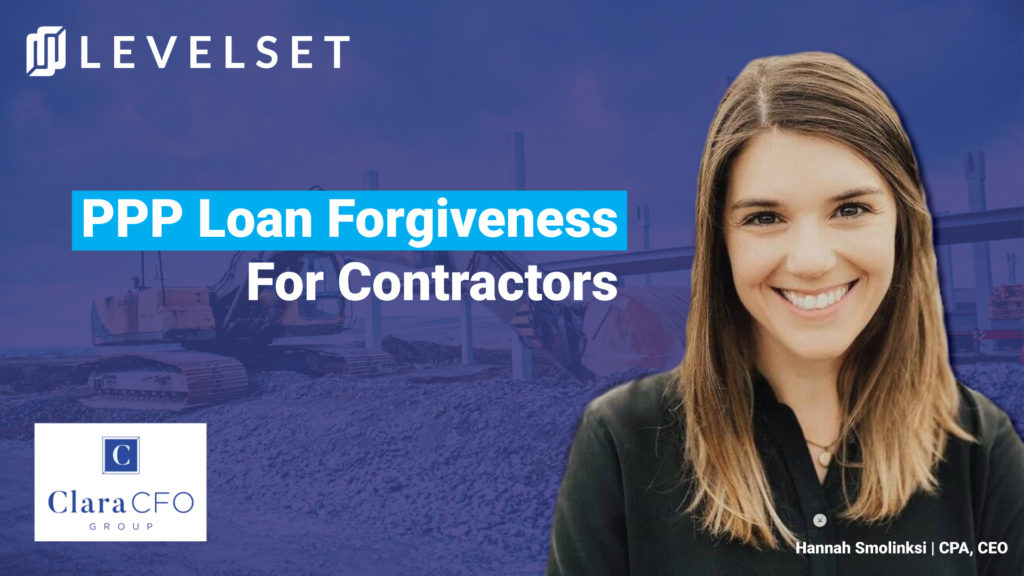
When the SBA rolled out the Paycheck Protection Program (PPP) at the onset of the pandemic, they provided forgivable loans that helped keep a number of struggling construction businesses afloat. But now, with loans coming due, contractors need to understand the PPP loan forgiveness process.
With the U.S. Small Business Administration (SBA) offering total forgiveness if you use your PPP funds properly, many companies are scrambling to make sure they hit those criteria just right. It’s a balancing act, and with the amount of gray area involved, some folks feel like they’re taking a shot in the dark.

To help affected businesses, Levelset reached out to Hannah Smolinski, CEO and Founder of Clara CFO Group.
As a Certified Public Accountant, Hannah spends a lot of her time helping PPP loan recipients navigate their applications, usage, issues, and questions, while also offering forgiveness guidance.
Suffice it to say, the PPP is her thing.
Why the PPP was created
Before you dig too far into the weeds on PPP relief, it’s essential to understand what the point of the PPP was. One of the goals of the program was to maintain the status quo until the nation could get back on its feet after COVID-19 ran its course.
As Hannah says, “It was all about trying to keep employers keeping their employees on the payroll. We want to keep people employed.”
In other words, the PPP’s role was to supply businesses with enough cash to continue issuing paychecks, regardless of whether their employees were currently working or not.
Instead of laying off employees and canceling health insurance coverage and other important benefits, employees could stay home or work reduced hours without COVID pulling the economic carpet out from underneath them. Employers could keep their employees on the books.
This is a valuable point to keep in mind, especially when it comes to applying the guidance for forgiveness.
Using PPP loan funds
The PPP provided a forgivable loan, not a grant. There are guidelines around how you can use the money in order to qualify for 100 percent forgiveness.
Essentially, the rule is that you need to use at least 60 percent of the money toward payroll costs, and the remaining 40 percent can go toward specific non-payroll costs.
That’s not to say you need to hit those percentages perfectly. The hard requirement is that you must hit the 60 percent threshold with payroll costs. But, you could spend as much of the funds over that threshold as necessary to make payroll. If you spent 100 percent of the money on pay-related costs, you’re in line for forgiveness.
When it comes to non-payroll costs, you could spend that 40 percent on mortgage interest, rent, or utilities. There are more rules that apply to these usages, but the remaining 40 percent must find its way toward paying these bills.
The PPP time frame: 24 weeks
Originally, you needed to use all of your PPP money within eight weeks. The idea here was that using your cash within a short amount of time would infuse the economy with cash and allow folks to live as normally as possible. But, eight weeks proved to be tough for some businesses to spend 60 percent of their cash on payroll.
In June, when the CARES Flexibility Act passed, the usage window expanded to 24 weeks from the time you received the money.
What does the SBA count as payroll costs toward forgiveness?
The 60 percent threshold is really the magic mark, and making that threshold can mean the difference between carrying a loan or forgiveness. It’s important to understand what counts toward payroll in the SBA’s eyes — and what doesn’t.
Hannah says simply, “the money needs to be spent for employees.” She went on to say, “Employees are the people you’re actually paying W-2 wages to.” She further explained that in construction, there tend to be a lot of contractors, subcontractors, and independent contractors. None of them count toward payroll costs. W-2s are the distinction.
As far as your W-2-receiving staff, these costs do count:
- Cash compensation, including salaries, hourly wages, tips, bonuses, commissions, cash stipends, and similar costs
- Retirement and healthcare contributions including 401k contributions, retirement plans, union retirement benefits, health insurance, dental insurance, and other typical benefits
- Any state and local taxes that a business typically pays based on payroll, such as state unemployment insurance
Cash compensation for all employees cannot exceed a $100,000 annualized salary. You can’t include any payments in excess of that mark for any individual employee.
You also can’t include worker’s compensation or federal payroll taxes.
What non-payroll costs can I use the funds for?
If you don’t have enough payroll costs to come up with 100 percent of your PPP loan, there are other costs that you can include toward your forgiveness. The amounts used for the following costs can add up to 40 percent of your original loan amount, but they don’t have to.
- Mortgage interest, including any interest on a secured loan. This includes interest on loans for land, properties, and equipment. Essentially, any loan secured with collateral owned by your business and paid for by the business.
- Rent and lease payments on offices and facilities.
- Utilities like electricity, telephone costs, internet, water, and gas.
However, these costs “had to be in place as of February 15, 2020,” says Hannah. “Because the PPP was really meant to try to maintain status quo, they weren’t wanting you to go out and acquire new properties and add new costs with this money.”
This means that if you’re using non-payroll costs to account for up to 40 percent of your original loan amount, they need to be costs you were already paying before February 15, 2020. New costs, investments, or expansion won’t apply toward forgiveness.
Accounting for Incurred Costs
There are two ways to account for the cash you spent toward forgiveness: actual cash paid and incurred costs. While most businesses won’t have issues spending their loan amount within the 24-week period, taking advantage of incurred costs can help.
How incurred costs apply is simple: If you received your loan amount on May 1st, that’s when your 24-week period begins. But, if your normal payroll cycle for the last two weeks of April pays out in May, you can consider the April costs as “incurred” and, therefore, they can count toward your 60 percent payroll threshold.
Likewise, if your 24-week window ends October 31, but you incurred utility costs that will be due in November within your window, you can count those costs toward the non-payroll expenses.
Major Concerns for Contractors
For contractors, Hannah sees four major areas of concern when it comes to navigating forgiveness.
Too Much Money
While it might seem like a good problem to have at face value, some businesses received too much money and found it difficult to spend on the appropriate costs. Hannah stated, “When the banks were first accepting applications, many of the bankers did not know how to guide people in requesting the right amount.” It was essentially up to the borrower to read and understand the guidance.
The good news is that the Flexibility Act expanded the window to use your funds to 24 weeks, and there haven’t been any requirements to send back any of the “extra cash” so far.
Tax Effect of PPP
With the passage of the most recent stimulus bill, Congress has clarified that the PPP will not count as taxable income AND the expenses you’ll be able to deduct them for taxes, even if forgiven. This essentially means that there is no tax effect of the PPP.
Owner’s Compensation
One of the more misunderstood aspects of the PPP is the concept of owner’s compensation. While the original intention of the PPP was to pay employees, Hannah states that the SBA “realizes that keeping owners paid is also very important.”
But, the SBA also wanted to avoid owners using the PPP as a financial windfall.
Much of the compensation rule depends on your tax status, but essentially, the amount the owner can take in compensation hinges on their 2019 personal income from the business. But it’s not that cut and dry. Owners can’t take 24-weeks of compensation under the PPP like an employee.
To determine how much of the PPP funds they can take themselves, owners need to take their personal taxable income, divide it by twelve, and then multiply it by 2.5.
So, if a business owner made $96,000 in taxable income in 2019 on their Schedule C as a Sole Proprietor, they can take $20,000 ($96k divided by 12, then multiplied by 2.5) in cash as their payment from the PPP loan. Sole proprietors will base this number on their 2019 net profit, while S and C-corp owners will base this on their 2019 W2s.
And this amount cannot exceed $100,000 per owner. Also, if you have less than 5 percent ownership in the company, you can take a 24-week draw like a regular employee.
PPP Forgiveness Forms
One of the most confusing aspects of the PPP is figuring out which forgiveness form will work for your situation.
There are four forms:
- 3508 S: Applies for loans under $50,000. It’s the simplest form of the three, and it doesn’t require you to prove out headcounts. Hannah says, “If you can use it, use it.”
- 3508 EZ: This applies for businesses that didn’t reduce their wages by 25 percent and: didn’t reduce their headcount or have to shut down due to a government mandate caused by COVID. Hannah stresses that it’s important to document which government agency shut you down.
- 3508: Applies for everyone else that the S and EZ do not cover. It’s the least straightforward of the forms. By a longshot.
- 3509: Borrowers with loans over $2 million need to fill out form 3509 to inform the SBA of its liquidity and business activity during the covered period.
There could also be an additional form coming for loans under $150,000, though it’s not yet available.
Document Everything
Hannah stressed that business owners applying for PPP forgiveness need to document everything. This includes any expense you’re applying toward payroll and any non-payroll costs.
One crucial aspect to document includes headcount. If you had to lay off any employees, the SBA wanted you to hire them back with the loan funds. If those employees refuse to come back to work, document it. Whether it’s an email, text message, or phone call, write it down or save it.
PPP Forgiveness Q&A
Q: Are sole proprietors required to go off of 2019 tax returns? What if the loan decision doesn’t occur until 2021? Will that change anything?
Hannah: No, I don’t think so. The whole point of going back to 2019 is to keep people in the status quo for 2020. They’re really trying to get a baseline of before COVID.
Q: Are prepaid rent plans applicable for non-payroll costs?
Hannah: Yes, you can prepay rent, but only for one month ahead.
Q: How are employee stock-ownership plans factor into ownership compensation?
Hannah: Stock ownership plans typically don’t have stock transfer to the employee until a much later vesting date. Therefore, ESOPs are likely not going to have any effect on ownership percentages.
Q: If someone works from home or uses their home as an office, how are those different forgiveness taken into account?
Hannah: If you received the correct loan amount to begin with, you won’t have to take into account any home expenses. But, if you take your home office as an expense on your tax return normally, you can take a portion of those expenses and apply them to the non-payroll amounts. But, the amounts start to get so small that it might not be the best route to go.
Q: Are employer-paid union health benefits part of eligible payroll costs?
Hannah: Yes, they would be employee healthcare costs. You just want to show what the obligation is, such as a rate you pay per employee. Document any statements you might receive from the union.
Q: How liberal are utilities as non-payroll expenses?
Hannah: I wish the SBA would come out with really specific guidance for utilities. But, it would be all the typical things you would think of; electricity, gas, phone, and internet. There has been some gray area around cell phones, but in my opinion, they should be included. That’s how people are running their businesses these days.
Q: Is there a maximum amount that a company could have received in order to still use the EZ form?
Hannah: I’ve found no documentation with a limit.
Q: Is the owner’s income part of the total payroll costs?
Hannah: Banks have been asking for owner’s compensation to be pulled out on a separate line. They’ll ask for specific documentation, but ultimately it will all roll back into payroll costs.
Q: What can you do about headcount reduction if employees left voluntarily and you were unable to rehire those people?
Hannah: This was a common issue. A lot of people who were laid off were refusing jobs or not responding to employers who were trying to hire them back. If the employer made a good faith offer to rehire the position, and the employee refused or didn’t respond, that position could be exempt. Also, if you’re unable to find another person with the required skill level to take that position, you don’t have to restore that position.
Be sure to keep any documentation that you used to offer those positions and whatever job postings you advertised, as well as any interviews you hold. Keep documentation on everything.
Q: How can an S-Corp owner handle any further compensation beyond their 2019 W2 wages?
Hannah: S-Corp owners can take their W2 wages, divide them by twelve, and then multiply them by 2.5. That is their maximum compensation (which can’t exceed $100,000). You can’t take any additional draws beyond that.
Q: What if a spouse without ownership stake in the company is on the payroll?
Hannah: If a spouse is an employee and has less than 5% ownership, you can treat them as an employee. They’re entitled to 24 weeks of compensation. There’s no red tape, no need for a note in the file.
Q: Is interest on a work truck lease applicable for non-payroll costs?
Hannah: The terms of the PPP say “mortgage interest.” A mortgage is a different financial instrument than a lease. I would not include lease interest in the PPP.
Q: Are there any forgiveness issues related to a growing headcount?
Hannah: No, your headcount growing is not an issue. As long as you’re using the money correctly, there are no problems related to forgiveness and a growing headcount.
Q: Are commission payments alright to use toward payroll costs?
Hannah: Yes, they are. Even if your salesperson doesn’t meet their numbers, you can use their entire compensation package from 2019 to provide a baseline in order to make them whole.
Q: If an employee received payment while on COVID leave, but their sick leave and holiday pay was tapped, does that count toward payroll costs?
Hannah: Their holiday and sick pay are both part of their cash compensation package, so it absolutely counts toward payroll costs.
